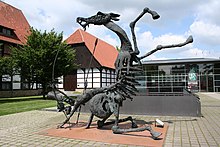Wilfried Koch
Wilfried Koch (born January 24, 1929 in Duisburg ) is a German artist , art historian and writer . He has lived with his wife Hilde in Rietberg - Varensell in the Gütersloh district since 1971 .
Create
As an art historian, Wilfried Koch became known to a wide international audience through his Brief Stilkunde der Baukunst (1967) and the great architectural style - European architecture from antiquity to the present (1982). The standard work for architects (“Der Koch”) is also considered understandable for laypeople. It contains 2,800 architectural pen drawings by the author. The two books have so far been published more than 80 times in German and translated into more than 20 languages, including Russian, Chinese and Japanese. The total print run exceeds one million.

Wilfried Koch has painted and drawn over 1000 portraits and has devoted himself intensively to sculpture since 1982 . He created numerous bronze statues using the lost wax technique . In his larger-than-life sculptures he designed people in their emotional borderline situations and dealt primarily with topics from music, mythology and Christian iconography . His characteristic means of expression include open bowls from which he forms the trunk, arms and legs. He places distinctive and expressive carriers of facial expressions and gestures on the body: face, hands and feet. The distinctive "cooking hands" have become a stylistic term in his work. The most famous sculptures are: Peace: The Fall of the Apocalyptic Horsemen, Actors, Esther, Erdmann, Lamenting, Zeitbalance, Seer, Francis, Prophet, Triple Crowned Crucifix, Varus, Fool, Adam-Lilith-Eve.
As a professional concert recorder player and as a pioneer in the revival of this instrument, he has made a name for himself since the early 1950s through radio recordings and concerts at home and abroad.
1997 Koch became a Dr.-Ing. E. h. of the University of Kaiserslautern . In 2002 he was appointed to the European Academy of Sciences and Arts .
Together with his wife Hilde, Wilfried Koch established the “Foundation Dr. Wilfried and Hilde Koch ”. It contains the artistic and scientific legacy. In 2007 the couple donated the entire fund to the Rietberger Sparkassen-Stiftung as an endowment. The city of Rietberg bought the monastery garden of the former Franciscan monastery. With eleven bronze sculptures, it became the “Wilfried Koch Sculpture Park”.
Nearby, the city bought the building for the Wilfried Koch Museum. More than 100 paintings, over 700 drawings as well as the scientific and literary estate are shown in six changing exhibitions every year. Eight bronze sculptures stand in the museum gardens.
Other sculptures found at the Technical University of Kaiserslautern, the Orthodox Academy of Crete and the Kazantzakis Museum in Crete.
swell
- ↑ Images of man by Dr. Wilfried Koch. Themes, design, stylistic devices. Explanatory text from the Wilfried Koch Foundation, accessed in January 2020.
- ↑ Guide through the sculpture park and museum in Rietberg.
- ^ Rietberg: Wilfried Koch's life's work will remain in Emsstadt forever (archive version). April 20, 2007, archived from the original on May 2, 2007 ; Retrieved January 18, 2015 .
Works
- A brief history of architecture , 1967
- Architectural style - European architecture from antiquity to the present , 29th, revised edition 2009, ISBN 978-3577102315
- The fairy tale of the good person , 1965, 3rd edition 2010, ISBN 978-3-924088-12-5
literature
- Wolfgang Morisse: Father of the “architectural style” , in: Westfalenspiegel , edition 3/2011, pp. 56–57.
Web links
- Literature by and about Wilfried Koch in the catalog of the German National Library
- Wilfried Koch in the Lexicon of Westphalian Authors
- Wilfried Koch Foundation
| personal data | |
|---|---|
| SURNAME | Cook, Wilfried |
| BRIEF DESCRIPTION | German painter |
| DATE OF BIRTH | January 24, 1929 |
| PLACE OF BIRTH | Duisburg |
